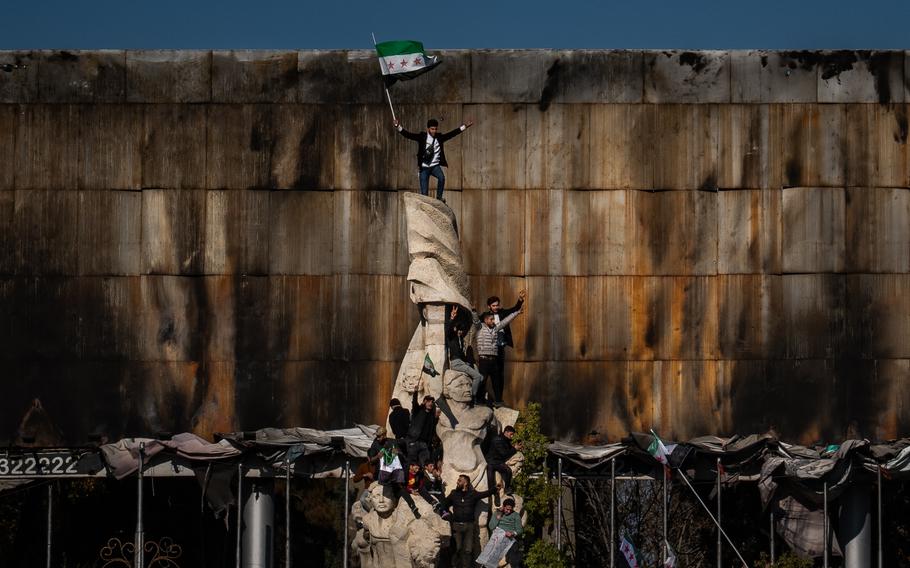6 key events that shaped the Middle East since Oct. 7, 2023 | Stars and Stripes

Syrians gather at Saadallah al-Jabiri Square during a victory celebration in Aleppo, Syria, on Dec. 13, 2024. (Salwan Georges/The Washington Post)
Hamas’s deadly assault on Israel on Oct. 7, 2023, was meticulously planned and devastating in nature. But few could have foreseen how the impact of the attacks would be felt across the region, from wars in Gaza and Lebanon, to a rapidly escalating conflict with Iran that President Donald Trump is contemplating joining.
Here are six key events that have shaped the Middle East over the past 20 months.
Deadly Hamas-led attacks shock Israel
On Oct. 7, 2023, Hamas-led militants stormed into Israel from Gaza, killing about 1,200 people and taking another 251 captive, according to Israeli authorities — in what is now regarded as the deadliest and most brutal attack in the country’s history. The militants’ targets included military posts, communal settlements known as kibbutzim and a music festival. U.N. experts later found “reasonable grounds to believe” that some of those killed or taken captive were sexually assaulted or tortured.
More than half of the hostages have since been freed, mostly in exchange deals early this year and in November 2023. Dozens of others were killed — including some who were killed in the Oct. 7 attacks and whose bodies were taken into Gaza, and others who died in captivity.
A second stage of the ceasefire earlier this year was supposed to secure the release of the roughly 20 hostages still believed to be alive in Gaza, but Israel broke the ceasefire in mid-March.
War in Gaza kills tens of thousands, decimates Hamas’s leadership
Within days of the Oct. 7 attacks, Israel’s leadership vowed to destroy Hamas and declared a “complete siege of Gaza,” which had already been under a blockade for 16 years. A ground invasion soon followed.
Over the past year, Israel has killed many senior Hamas figures, including Ismail Haniyeh, the head of the group’s political bureau who was killed in Iran in July; the commander of the group’s military wing, Mohammed Deif; and Yahya Sinwar, the architect and leader of the Oct. 7, 2023 attack. The Israeli campaign depleted Hamas’s military strength and opened a leadership void inside Gaza.
The war has also had a devastating impact on the Palestinians living in Gaza.
According to Gaza’s Health Ministry, the war has now killed more than 55,000 people and injured almost 130,000 others. While the ministry does not distinguish between civilians and combatants, it says that majority of the dead are women and children. And, according to Palestinian journalists, first responders, international aid workers and war-casualty watchdogs, the ministry’s death toll is probably an undercount, with the bodies of many of those killed still under the rubble.
International bodies have repeatedly spoken out about of the risk of famine inside the Strip, with doctors and nutrition experts warning of the lifetime health risks that children who survive the war will face. The United Nations says that 90 percent of Gaza’s population has been displaced, without access to sufficient food, water, shelter, medical services or education.
In the occupied West Bank, meanwhile, Israeli land grabs, settlement expansion and demolitions in Palestinian communities have led to the most significant territorial changes in the area in decades.
Yemen’s Houthi rebels threaten global shipping
In November 2023, Yemen’s Iran-backed Houthi rebels declared that they would target shipping in the Red Sea in response to Israel’s actions in Gaza.
Their attacks caused major disruption to one of the world’s busiest shipping routes, with as many as 12 out of every 14 container ships, along with a large share of oil and gas tankers, choosing to travel around southern Africa rather than risk the much shorter journey toward the Suez Canal, as The Post reported in December 2023.
The creation of a multinational naval coalition to protect commercial shipping and months of U.S.-led airstrikes did little to deter the militants, with the Pentagon recording 190 attacks on either U.S. military vessels or commercial shipping off the coast of Yemen by June 2024.
In May this year, Trump announced the United States would end its campaign against the Houthis, saying that the group had agreed to end their attacks on U.S. ships, under a ceasefire brokered by Oman.
Conflict spreads to Lebanon; Hezbollah’s leader killed
Lebanon’s Iran-backed Hezbollah also launched attacks in solidarity with Hamas, prompting almost a year of low-level fighting across the border between Lebanon and Israel.
Israel then stepped up its attacks on Hezbollah — including with an attack on the group’s communication devices, which killed or maimed as many as 3,000 Hezbollah officers and members, along with an unknown number of civilians, according to Israeli, U.S. and Middle Eastern officials. Israel also carried out strikes that killed Hezbollah’s longtime leader, Hasan Nasrallah, and other top officials; and later a ground invasion of the south of the country.
The war ended with a ceasefire in November — and a humiliating defeat for the group.
But the war also ravaged Lebanon. According to a death toll at the time from Lebanon’s Health Ministry, at least 3,768 people have been killed by Israeli strikes in Lebanon between October 2023 and the start of the ceasefire — more than a quarter of them women and children.
A rebel insurgency overthrows Syria’s Assad
A lightning rebel advance in Syria late 2024 brought yet more drama to the region’s political stage as Bashar al-Assad, whose regime withstood and brutally repressed the 2011 uprising, was finally overthrown by opposition forces.
Assad was soon replaced by a very unlikely figure: Ahmed al-Sharaa, previously known by his nom de guerre, Abu Mohammed al-Jolani, who spent time in a U.S. prison in Iraq before leading an al-Qaida affiliate during the Syrian civil war (the group later broke ties with al-Qaida).
Within weeks of Assad’s removal, the United States lifted the $10 million bounty on Sharaa. This year, Syria’s new president met with Trump, who announced the lifting of sanctions on Syria
While Assad’s overthrow was not a direct consequence of the Oct. 7, 2023 attacks, the rebels were able to take advantage of the weakness of his main backers: Iran and Hezbollah, both involved in the widening war in the Middle East, and Russia, preoccupied with its war in Ukraine.
Israel also seized on Assad’s overthrow, taking military posts inside Syrian territory within hours of the rebel takeover and later announcing that Israeli troops would occupy a buffer zone within Syria for the foreseeable future.
Israel and Iran enter their biggest direct conflict ever
Iran and Israel began openly trading strikes in 2024, initially triggered by a fatal Israeli strike on the Iranian consulate in Damascus. But their conflict entered a much wider, and more intense, phase this June, as Israel attacked Iranian nuclear, military and energy sites, and Iran unleashed barrages of ballistic missiles and hit a hospital in southern Israel.
The attacks mark the most sustained, direct fighting ever between the two regional rivals. But it comes as Iran is weakened — with a number of the country’s top military figures and scientists killed in Israel’s June attacks, and the groups that made up its “axis of resistance,” including Hamas, Hezbollah, the Assad regime and the Houthis — also suffering setbacks.
Now, with Trump openly mulling whether to strike Iran and draw Washington into a new conflict in the Middle East, there are fears the wider region could get drawn in, with one analyst describing the current showdown as “the worst nightmares come true.”











